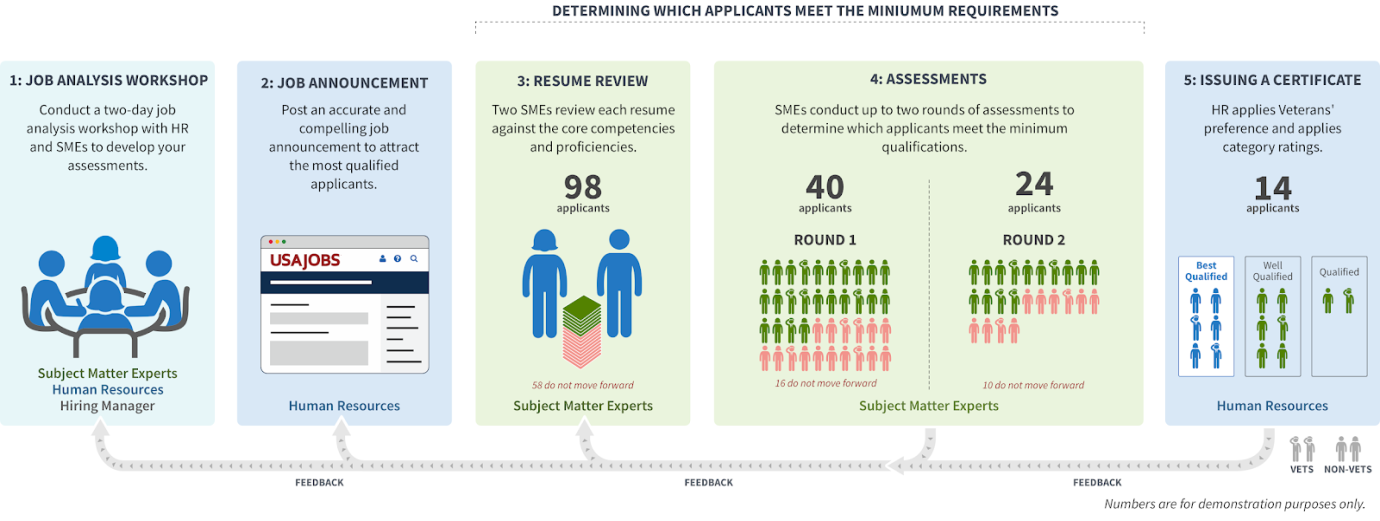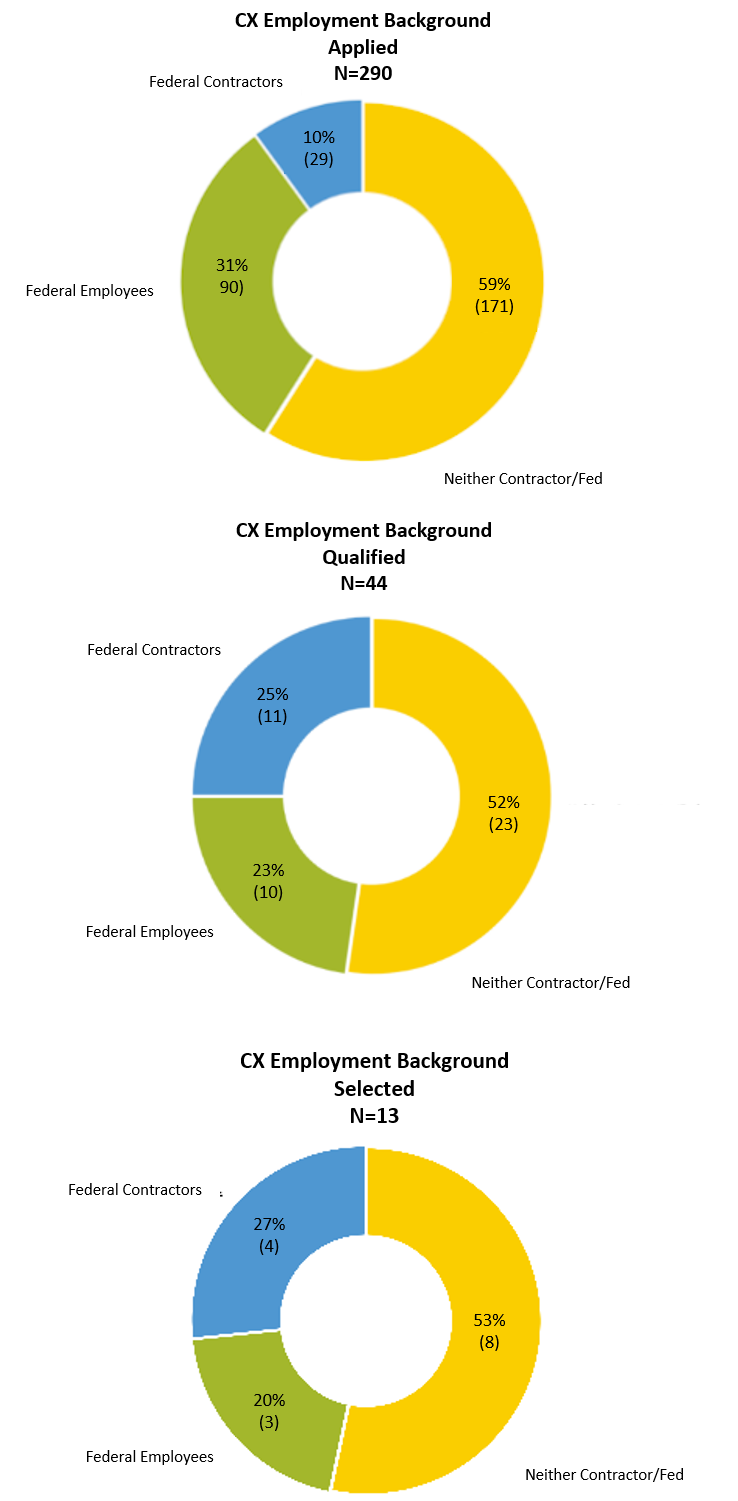PMA
The federal government needs customer experience (CX) and design professionals. These experts ensure the public receives well-designed, more efficient services. Given that each agency only wanted to hire a few CX professionals and that effective assessments take time to administer, the government recently experimented with a new way to hire effectively in the competitive service. Rather than each agency doing separate job announcements only using a self-assessment questionnaire, in this action, 20 CX experts across nine federal departments decided to work together on one shared job announcement. The goal was to qualify and effectively assess all applicants so that we could try to place every single qualified applicant somewhere in the government.
This hiring experiment — moving away from the self-assessment questionnaire and toward subject matter expert based assessments — reflects the broader President’s Management Agenda to improve hiring outcomes as well as a recent Executive Order that requires agencies to use qualifying assessments other than the self-assessment questionnaire. Although there have been seven successful Subject Matter Experts (SME) based qualifying assessment pilots in the last year, this marks the first pilot that was government-wide. Today, the majority of job announcements do not use qualifying assessments outside the self-assessment questionnaire so this pilot helped show an example of how agencies can think outside the box to fill competitive openings with top technical talent.
This pilot proved that within six weeks of positing a job announcement, hiring managers can be presented with a list of truly qualified applicants, with qualified Veterans at the top of that list. Thus far, of the 44 applicants who qualified at the GS-13, 14, and 15 levels, exactly half have been selected by an agency and 17 have accepted their offer. The feedback from hiring managers and applicants alike has been overwhelmingly positive. This post will dig into the details of what this took and what needs to happen moving forward to continue this work.
The pilot
This undertaking required significant coordination and expertise. U.S. Digital Service (USDS) had been partnering with Office of Personnel Management (OPM) for the past year to codify that this type of approach — having SME partnering with HR to write the qualifications and pass/fail assessments to measure those qualifications — is allowed within competitive hiring laws and regulations. This approach — known as Subject Matter Expert Qualification Assessment (SME-QA) is now documented in the OPM Human Resources (HR) hiring handbook and in OPM policy memos. This strategy ensures only qualified applicants make it through the competitive hiring action, with the goal of selections off every job announcement that is open to the public. If we advertise a job publicly, we should make a selection off that announcement.
To coordinate the hiring action, USDS and the cross-agency Federal Customer Experience Team joined forces with OPM Staff Acquisition to make this hiring action a success. As reflected in the hiring diagram below, this hiring strategy requests SMEs, comprised of high performing government employees working in the same position at or above the grade- level being hired, work with HR professionals for two days to document the required specialized experience in the form of competencies and proficiency levels. Next, they create pass/fail assessments (such as written prompts or structured interviews) to evaluate applicants against those requirements. Only applicants who pass both assessments, and pass an initial SME resume and work sample review, are eligible for the position. Veterans’ preference is applied to the applicants who are found eligible after passing the two qualifying assessments.


In this pilot, after applicants applied for the position, the SMEs reviewed a design portfolio work sample and three pages of each resume submitted to see which applicants would qualify for entry into the first of two assessments.
The 124 applicants who passed resume review, took the first assessment which was an asynchronous interview using the HireVue platform. Applicants received a link to record themselves answering four questions. Applicants had a minute to prepare their answer and then had multiple chances to record themselves answering the questions using audio. No video or Artificial Intelligence required. Those who passed this round proceeded to a longer one-on-one structured phone interview with a CX SME. HR played a key role throughout the process training the SMEs and reviewing their justifications about why they were or were not moving each applicant forward. Only applicants who met the minimum qualification bar and demonstrated proficiency for each required competency were considered eligible for the position. At the end, of the 44 applicants who passed both assessment rounds, HR adjudicated Veterans preference, put applicants into categories based on if they “exceed” the requirements during the structured phone interview, and issued the certificates. The certificates were issued to hiring managers exactly 6 weeks after the job announcement first posted.

This is the smartest government thing I've ever seen. The way that it is multi-agency, you only have to apply once. It didn't involve all the super long and crazy paperwork that you usually associate with a government job. It makes it much more doable.” - CX Applicant
One of the highlights of the process is that private sector applicants don’t need to know the typical tricks of federal employment, including much longer federal style resumes and the problem of over inflation on self-assessment questionnaires. In this process, SMEs are doing the evaluation, not the applicants; and, applicants with 2-3 page resumes are on equal footing as federal applicants with much lengthier resumes. The chart below compares the sectors where applicants came from versus where the qualified applicant pool came from, and shows how federal employees, contractors, and private sector applicants all made it through this process.

Though we had initially advertised 30 vacancies for this announcement, changing priorities due to COVID, resulted in 15 available vacancies to fill at the participating agencies. Of the 44 qualified applicants, thus far 22 offers have been extended with 17 acceptances to date. This includes selections from three agencies who did not originally sign up to participate in this government-wide effort. The remaining applicants will remain available for selection for a full year and work is starting on a shared certificate platform to encourage this practice.
The caliber of candidates was above and beyond my own candidates and recruitment.” - Dept. of Ed Hiring Manager
Making effective assessments work at scale
Taking this type of hiring strategy from the pilot phase to helping it scale across the government will take several critical steps. The coordination aspect is key and over the past year USDS has received Cross Agency Priority funding to be able to help agencies coordinate these hiring actions for the first time they’re doing them. The government may need a permanent team out of OPM that can help agencies bridge the divide between policy guidance and the culture shift through hand holding through initial hiring attempts.
On the agency side, it helps to have a talent team that is focused on the applicant experience. That includes a comprehensive recruitment strategy and really effective communications so applicants don’t feel lost in the process. Talent teams also excel at looking at data to analyze the results of previous hiring outcomes that answer questions beyond ‘”how long did that take?,” and really dig into ‘what was the qualify of that certificate?” “how happy are the hiring managers?” and “are there always selections by hiring managers off the lists we provide to them?”
Finally, the technology must help agencies walk through more effective hiring flows that encourage the use of alternative assessments. In this last regard, USDS and OPM have been partnering on several developments all used in this pilot:
-
A Cloud-based resume review platform built by the U.S. Digital Service enables SMEs from across the government to participate in the process remotely. The tool aims to make resume review less subjective by requiring two SMEs to independently review every resume with a third SME breaking any tie. Additionally, instead of SMEs defaulting to what “qualified” means in their head, the tool lays out each required proficiency level and the SMEs are bound to just review those to determine qualifications.
-
Asynchronous 20 minute interviews on HireVue allowed candidates to record their answers to interview questions within a five-day deadline. Due to the COVID-19 pandemic, providing an option that allowed both applicants and SME reviewers the ability to provide and review interview question responses at times that worked best for them allowed for increased flexibility and faster completion. The participating SMEs were able to add a more personal touch by uploading videos of federal employees introducing themselves and asking interview questions.
-
Digital scheduling software ScheduleOnce streamlined the second-round interview scheduling process and saved time for all personnel involved in qualifying interviews.
No process is ever perfect, but this allows good candidates to shine and surface bad candidates when they don't have enough experience.” - CX SME
We are looking forward to working with more agencies as they work to scale this process across various job series and grade levels in the competitive service. The federal government must have the talent and skills needed to provide the best services to the American people. Every applicant must have a chance to be assessed based on merit in a truly fair and open competition.
